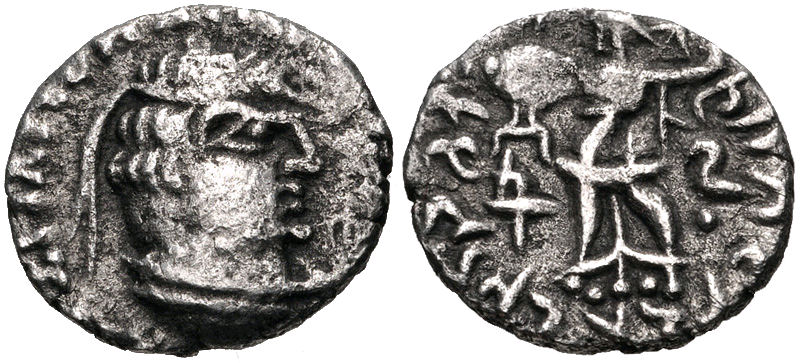Strato III on:
[Wikipedia]
[Google]
[Amazon]
Strato III Philopator (; epithet means "the Father-loving") was an
/ref>
 Subsequent Indo-Scythian rulers, who replaced the Stratos in their territories, designed their coins in direct imitation of those of Strato II and Strato III. This is the case of the Northern Satraps, who ruled in the territories from Sagala in Eastern
Subsequent Indo-Scythian rulers, who replaced the Stratos in their territories, designed their coins in direct imitation of those of Strato II and Strato III. This is the case of the Northern Satraps, who ruled in the territories from Sagala in Eastern
Les Rois Straton II et III
{{Indo-Greek kings Indo-Greek kings 1st-century monarchs in Asia Euthydemid dynasty
Indo-Greek
The Indo-Greek Kingdom, also known as the Yavana Kingdom, was a Hellenistic period, Hellenistic-era Ancient Greece, Greek kingdom covering various parts of modern-day Afghanistan, Pakistan and northwestern India.
The term "Indo-Greek Kingdom" ...
king who ruled c. 25 BCE to 10 CE. He is only known through the joint coins with his father Strato II. He may have been supplanted, in conjunction with his father or later as an independent king, by the Indo-Scythian Northern Satraps, particularly Rajuvula and Bhadayasa, whose coins were often copied. Strato was the last of the line of Diodotus and independent Hellenistic
In classical antiquity, the Hellenistic period covers the time in Greek history after Classical Greece, between the death of Alexander the Great in 323 BC and the death of Cleopatra VII in 30 BC, which was followed by the ascendancy of the R ...
king to rule at his death in 10 AD.The Dynastic Arts of the Kushans, John M. Rosenfield, University of California Press, 1967, p.13/ref>
Coinage
Strato III may also have issued coins on his own, but these are rare and unconfirmed. A few silver coins with a different portrait and the inscription Strato Soter ''Dikaios'' ("the just") may also belong to Strato III as sole ruler, or to a fourth king named Strato.Senior, ibid. Just like the earlier king Strato I, Strato III is thought to belong to the dynasty of Menander I, who also used the epithet Soter and the symbol of standing Pallas Athena. The chronology of the late Indo-Greek kingdom has been established by Bopearachchi and other scholars from numismatical evidence alone. The coins deteriorated continuously, the Strato coins being the most debased and crude in style, a striking contrast to earlier kings who struck some of the most beautiful coins of antiquity. The decay was due to the increasing pressure of the Indo-Scythian nomads on the remaining Greek pockets, as well as their long isolation from the rest of the Hellenistic world. Strato II, Strato III and Strato Dikaios struck debased silver drachms, which as mentioned portray Pallas on the reverse. Strato II appears as an old man with a sunken jaw on some of his coins, which is not surprising given that his grandson was co-regent. Strato II also issued bronzes and even lead coins of the common type Apollo/tripod. On some of Strato II's silver drachms the lettersigma
Sigma ( ; uppercase Σ, lowercase σ, lowercase in word-final position ς; ) is the eighteenth letter of the Greek alphabet. In the system of Greek numerals, it has a value of 200. In general mathematics, uppercase Σ is used as an operator ...
is written as C, a not uncommon trait on late Hellenistic coins in the east.
Successors by Indo-Scythian rulers
 Subsequent Indo-Scythian rulers, who replaced the Stratos in their territories, designed their coins in direct imitation of those of Strato II and Strato III. This is the case of the Northern Satraps, who ruled in the territories from Sagala in Eastern
Subsequent Indo-Scythian rulers, who replaced the Stratos in their territories, designed their coins in direct imitation of those of Strato II and Strato III. This is the case of the Northern Satraps, who ruled in the territories from Sagala in Eastern Punjab
Punjab (; ; also romanised as Panjāb or Panj-Āb) is a geopolitical, cultural, and historical region in South Asia. It is located in the northwestern part of the Indian subcontinent, comprising areas of modern-day eastern Pakistan and no ...
to Mathura, such as Rajuvula.
Just as the Yuezhi
The Yuezhi were an ancient people first described in China, Chinese histories as nomadic pastoralists living in an arid grassland area in the western part of the modern Chinese province of Gansu, during the 1st millennium BC. After a major defea ...
had copied the coins of the last Greco-Bactrian ruler Heliocles in Bactria
Bactria (; Bactrian language, Bactrian: , ), or Bactriana, was an ancient Iranian peoples, Iranian civilization in Central Asia based in the area south of the Oxus River (modern Amu Darya) and north of the mountains of the Hindu Kush, an area ...
, or the Indo-Scythians had copied the coins of the last western Indo-Greek
The Indo-Greek Kingdom, also known as the Yavana Kingdom, was a Hellenistic period, Hellenistic-era Ancient Greece, Greek kingdom covering various parts of modern-day Afghanistan, Pakistan and northwestern India.
The term "Indo-Greek Kingdom" ...
ruler Hermaios in the area of Kabul
Kabul is the capital and largest city of Afghanistan. Located in the eastern half of the country, it is also a municipality, forming part of the Kabul Province. The city is divided for administration into #Districts, 22 municipal districts. A ...
, here again the Indo-Scythian Northern Satraps relied heavily on the numismatics of their predecessors.
See also
*Indo-Greek Kingdom
The Indo-Greek Kingdom, also known as the Yavana Kingdom, was a Hellenistic period, Hellenistic-era Ancient Greece, Greek kingdom covering various parts of modern-day Afghanistan, Pakistan and northwestern India.
The term "Indo-Greek Kingdom" ...
* Greco-Buddhism
* Indo-Scythians
Notes and references
Notes ReferencesBibliography
* At the Internet Archive.External links
*Les Rois Straton II et III
{{Indo-Greek kings Indo-Greek kings 1st-century monarchs in Asia Euthydemid dynasty